Text
The Critical Analysis
Tompkins, J.E. and Martins, N. (2021) 'Masculine pleasures as normalized practices: Character design in the video game industry,' Games and Culture, 17(3), pp. 399–420. https://doi.org/10.1177/15554120211034760.
I have chosen pages 406 to 407 of this article, Masculine Pleasures as Normalized Practices: Character Design in the Video Game Industry. The reason is that these two pages focus on the core of the article, and I think the “feminized metaphors” and “male desires” mentioned in these two pages can explain why there is an invisible set of invisible rules behind the seemingly diversified appearance of character design in today's digital game industry.
I will first analyze the author's views on feminized metaphors and masculine desires and then present my thoughts.
First of all, after summarizing the interviews of dozens of industry professionals, the author compiled two main factors for the feminization metaphor: the first one is the fact that men mostly dominate the game industry, and the second one is the technical limitations of the current technology. I agree with the first point. The author quotes directly from the game developers and confirms that in the male-dominated game industry, it is easy to see the sexualization of women and stereotypical design from a male perspective, which also confirms feminism's criticism of the “male gaze” in the visual media, as women are still often depicted in the visual media as the object of men's desires. This also brings up another point: most mainstream games released today are still targeted at a male audience, so the game's character design has to cater to the preferences of that audience. However, I have reservations about the second point. The author mentions that due to the game engine's limitations in the early days, character creation had to be simplified to a certain extent, resulting in most of the characters wearing close-fitting clothes. Thus, the author suggests that the technology and software limitations inadvertently contributed to gender stereotyping. I think this may have made sense in the early days of the game industry. Still, I believe that today's technological power will not be the driving force behind gender stereotyping, not to mention that this does not limit many 2D art-style games, so I think it's hard for tools to be the driving force behind gender stereotyping, and that the real focus is still on the people who are using the tools. Design is human, and the real change will come from the people who use the tools.
The second author suggests that male desire is one of the reasons for the monolithic female characterization. In this section, the author explores why game designers consciously or unconsciously place game characters under the male perspective of gender expectations and ideals. Echoing the point in the previous section that the gaming industry is largely male-dominated and that men often rationalize gender, the author mentions that games usually portray female characters as “sexy and powerful” to show men's idealized imaginations of women. I think this is quite normal, as games target women nowadays. If you look at those games, you'll find that the male characters in games targeting women also have specific appearance characteristics, so I think it's normal for specific character appearance characteristics to appear depending on the type of game. However, the problem lies in the fact that mainstream games nowadays aren't obligated to serve either gender deliberately, so we can only find out the core of the problem by exploring why such games are prone to gender-stereotyped character designs.
Including realism in the context of male desire is the most interesting discovery in this article. The author notes that realism is applied to the differences between male and female game characters. To make female characters realistic, designers usually focus on the female character's body and personality. However, for male characters, the designers changed their focus and emphasized the male character's ability to move and function in the game world. This shows that the designers have followed the traditional stereotypes of how men and women are expected to be portrayed in character design. It reveals that women are still likely to have a specific body shape and feminine sensibilities. Men, on the other hand, are expected to display strong physical abilities and capabilities.
In conclusion, the author's analysis of gender stereotyping in digital game character design is worth reading. Not only does the author offer a unique perspective, but he also effectively combines interview data and theories to explain the complexity of the problem. With the progress of modern society, we are happy to see that it is becoming more and more diverse and that people can uniquely express themselves according to their self-identity. Games should also consider the changing social climate and show the diversity of human appearance in their character design. I don't object to sexy female characters in games. Still, I think the problem is that when the sexualization of women becomes an unquestioned rule, that's something that character designers need to be aware of. After all, if no one is the first to break the rule, the implicit rule will continue to be passed down in silence.
As I read the article, I couldn't help but reflect that I have this problem with my designs. It made me reflect on whether I had unconsciously adhered to a stereotypical gender rule when designing my characters or followed the character's personality and characteristics in my design. The most significant value of this article is that it provides game character designers with this kind of reflection. In the future, we will see more diverse character designs in games. After all, in the post-epidemic society, the impact of games is emphasized, and games have to bear more responsibility than ever before. I believe that if every game designer makes an effort to do so, there will be more characters with unique charms that go beyond the framework of gender.
0 notes
Text
Reader
Crawford, G. and Brock, T. (2024) ‘Just fun and games? A sociological consideration of fun in video games’, Games and Culture [Preprint]. Available at: https://doi.org/10.1177/15554120241254876 (Accessed: [6 Jan 2025]).
This paper explores the concept of "fun" in video games through a sociological lens, focusing on its role in game design, player experience, and its influence on real-world work environments. The authors critique the societal overemphasis on entertainment in games, which has led to a homogenization of gaming experiences. Instead, they argue that games should provide diverse emotional journeys, reflecting the developers’ intended messages rather than limiting players to singular emotional responses.
While the paper effectively examines how gaming concepts motivate workers, it overlooks other factors, such as personal motivation and cultural preferences. Despite this limitation, the paper offers valuable insights into how "fun" is understood and applied, making it a thought-provoking read.
------------------------------------------------------------------------------
Devine, T.C., Presnell, W.A. and Miller, S. (2014) ‘Games as art and Kant’s moral dilemma’, Games and Culture, 9(4), pp. 277–310. Available at: https://doi.org/10.1177/1555412014538812 (Accessed: [6 Jan 2025]).
The article argues that as more and more games claim artistic merit and influence, game designers must also assume the moral responsibility of artists. Therefore, the article analyzes the morality of one of the choice-oriented quests in Ectoplasm 3 by examining it and applying Kant's moral philosophy to it. I think the strength of this article is that it inspires me to think about whether there are other ways in which a game can bring more in-depth moral thinking to the player rather than just limiting the player's choices within the game by making them either black or white. But at the same time, if games are bound by the moral values of today's society, the core value of the game itself, which is to be free from reality, will be significantly lost, resulting in another level of unification. Therefore, it is worth pondering how much moral responsibility should be paid to games nowadays.
------------------------------------------------------------------------------
Díaz, C.M.C. and Tungtjitcharoen, W. (2014) ‘Art video games’, Games and Culture, 10(1), pp. 3–34. Available at: https://doi.org/10.1177/1555412014557543 (Accessed: [6 Jan 2025]).
The study focuses on how a specific type of game, art games, elicits and conveys emotions to players. The article suggests that art games can elicit particular emotions and reflections from players depending on the game's theme. It emphasizes that game mechanics are key to shaping players' emotional experiences and responses. The most interesting part of the article is that the research mentioned that players' emotions are not passively generated but instead constructed by actively connecting with the game characters based on players' own life experiences. This is why the emotional messages that game authors want to express are not the same as the ones that players feel. It is a pity that only one game was used in the study. However, it still inspired me to think about how the emotional messages brought by games are constructed during playing.
------------------------------------------------------------------------------
Feng, Z. (2025) ‘Exploring the etymology of YouXi: A Chinese perspective on the concept of game’, Games and Culture [Preprint]. Available at: https://doi.org/10.1177/15554120241308948 (Accessed: [6 Jan 2025]).
The article compares the Chinese word YouXi with the Western mainstream English word game. The author first analyzes the word You, which expresses freedom, leisure, and exploration in Chinese and emphasizes a carefree experience. Then, he analyzes the word Xi, which in Chinese does not mean seriousness, trickery, or performance but represents an activity detached from the real world. Finally, the author's definition of a game in English emphasizes competition, challenge, and conflict. From this, we can see the different values of games between the East and the West in the language system. One of the most interesting points in the article is that the author's point of view can be used to understand the historical and cultural differences between the East and the West in terms of the word game. However, both Chinese and English words will be updated and changed according to the events and experiences of today's society. However, the author's final definition of the word “game” as an experimental exploration of alternative life experiences is still worth thinking about.
------------------------------------------------------------------------------
Friedman, A. (2014) ‘The role of visual design in game design’, Games and Culture, 10(3), pp. 291–305. Available at: https://doi.org/10.1177/1555412014559977 (Accessed: [6 Jan 2025]).
The author advocates that a game's visual design is not just a superficial element of the game mechanism but one of the indispensable elements of game design. The author uses the Deleuzian “moving image” framework and symbolic theory to analyze the visual design of different independent games. However, Deleuze's “moving image” framework was developed for movies, and the most significant difference between movies and games is that movies are passive viewers and games are active players, so it is difficult to fully explain the visual design of games in this framework alone. However, this article still makes me think about the responsibility of visual design in game design and how visual design can make players more engaged in the game.
------------------------------------------------------------------------------
Karlsson, T., Brusk, J. and Engström, H. (2022) ‘Level design processes and challenges: a cross section of game development’, Games and Culture, 18(6), pp. 821–849. Available at: https://doi.org/10.1177/15554120221139229 (Accessed: [6 Jan 2025]).
This paper examines and compares the critical level design processes in game development. One of its greatest strengths lies in its ability to explain why level design is a highly interdisciplinary task by comparing how two game development teams approach the process. Through field studies and interviews, the paper allows readers to understand better the challenges and complexities involved in level design.
However, the scope of the study is limited, likely due to resource constraints, as it focuses primarily on two small and medium-sized companies in Sweden. This narrow focus may introduce some biases in the findings and raise questions about whether similar issues occur in larger game development companies.
Despite this limitation, the paper remains an excellent piece of research. It clearly outlines the difficulties game development teams face during the level design process, offering valuable insights that can significantly inform future approaches to level design.
------------------------------------------------------------------------------
Pearce, K.E., Kearney, M.C. and Giunta, M. (2021) ‘Families playing Animal Crossing together: Coping with video games during the COVID-19 pandemic’, Games and Culture, 17(5), pp. 773–794. Available at: https://doi.org/10.1177/15554120211056125 (Accessed: [6 Jan 2025]).
The article examines how some families coped with emotional and stress problems by playing Animal Crossing Together during the COVID-19 pandemic. The article clearly shows that families playing Animal Crossing Together were able to resolve emotional issues during the pandemic, such as effectively distracting themselves from the realities of the situation and resolving the social isolation of family members during the pandemic. I think that by examining the impact of Animal Crossing Together during the epidemic, the article explains why there was a significant increase in the number of people playing the game during the epidemic, and it confirms that the game can provide clear emotional value to the players and build connections with others. Unfortunately, the article relies on self-reported data from the interviews, which, while providing substantive insights, may have contributed to the objectivity of the findings. This does not detract from the benefits of the article.
------------------------------------------------------------------------------
Possler, D., Daneels, R. and Bowman, N.D. (2023) ‘Players just want to have fun? An exploratory survey on hedonic and eudaimonic game motives’, Games and Culture, 19(5), pp. 611–633. Available at: https://doi.org/10.1177/15554120231182498 (Accessed: [6 Jan 2025]).
The article concerns whether gamers will buy or play games based on pursuing eudaimonic experiences. The study shows that there are two different types of motives in games: hedonic motives and the other is eudaimonic motives. The difference between the two is that the first type of motives is to get pleasure from games, enjoy novel experiences, and relax, while the second type of motives is to seek personal growth and express their true selves and other meanings related to their values in games. What I find interesting about this study is that five different types of unpublished games were used to investigate this issue, and the results showed interesting differences in the importance of motivation among the five games. The results show interesting differences in the importance of motivation in the five games, which gives me a different perspective on the other pursuits and expectations of gamers for other types of games.
------------------------------------------------------------------------------
Shaw, A. (2011) ‘Do you identify as a gamer? Gender, race, sexuality, and gamer identity’, New Media & Society, 14(1), pp. 28–44. Available at: https://doi.org/10.1177/1461444811410394 (Accessed: [6 Jan 2025]).
The article wants to explore the identity of gamers, and the author believes that a simple generalization that all people who play games are gamers does not reflect personal experience, social cognition, etc. The article also finds that gender has more to do with gamer identity than sexual orientation or race. Meanwhile, the study found that gender is more related to gamer identity than sexual orientation or race. The interesting thing about this study is that it looks at gamer identity in the context of human diversity, which makes me realize that there are some problems with the term gamer. However, I agree with the article that those problems are caused by the stereotypical labeling of gamers by the mass media.
------------------------------------------------------------------------------
Tompkins, J.E. and Martins, N. (2021) ‘Masculine pleasures as normalized practices: Character design in the video game industry’, Games and Culture, 17(3), pp. 399–420. Available at: https://doi.org/10.1177/15554120211034760 (Accessed: [6 Jan 2025])
This article is about why the current video game industry is still characterized by gender stereotyping in the character design process. The first is that the target audience of most mainstream games is still mainly male, which makes it easy for female characters to appear to please men. At the same time, it may also be limited by the current game engine and 3D modeling software, which requires a lot of money to make a variety of characters' physiques, clothes, and external shapes. Therefore, it is difficult to create a variety of characters. The appearance of the character is difficult to be diversified. The best thing about this article is that it demonstrates why character design in the game industry still follows a set of invisible rules, both in terms of the target market and the working environment of the game. Reading this article made me reflect on whether I had been caught up in this invisible rule.
0 notes
Text
10. The Diverse World of Game Art Styles: How They Shape Player Experiences
As tech has advanced and more diverse games have entered the market, the art style of games has evolved significantly. Game art is always the first thing that grabs players' attention, and it's not just about how the game looks. It actually affects how immersed players feel, how emotionally connected they are to the game, and how deep their experience is. In this post, I'll explore how a game's art style directly influences the player's experience.
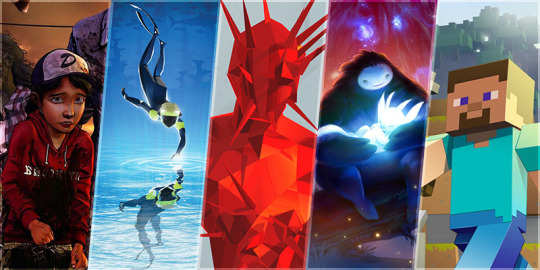
Game Art Style: Establishing Identity and Atmosphere
The core reason why game art style has such a profound impact is that it establishes the identity and atmosphere of the game world. Simply put, game art style is like an artist's painting style. Each person's unique painting style reflects their preferences and life experiences, conveying a strong personalized message. Similarly, a game's art style draws players into its unique world without the need for introductory text—just by allowing them to experience it visually.
Three Common Game Art Styles
1. Pixel Style
Pixel art has been a popular choice among gamers from the past to the present. Its charm lies in creating unique visual effects with minimal resources.
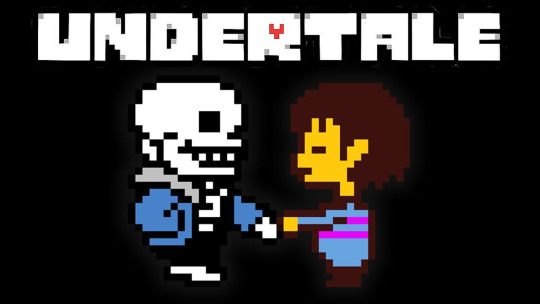
For example, Undertale is a standout pixel RPG. Its minimalist pixel style builds the game's visual world, strengthening the core characteristics of its characters while echoing the heart of Undertale's story. Additionally, pixel art evokes nostalgia for classic games, a feeling that's hard to replicate with other styles.
2. Hand-Drawn Style
The hand-drawn style is often found in indie games. This style maximizes the expression of the creator's personal touch and enhances the atmosphere of the game's worldview.

Hollow Knight exemplifies this beautifully. Its unique hand-drawn art style conveys a vast, intricate world filled with solitude and adventure, allowing players to feel its depth and mystery.
3. Realistic Style
Highly realistic 3D art is the go-to choice for modern AAA games. This style's ability to bring players close to reality enhances immersion and showcases technical prowess.

Take The Last of Us Part II, for instance. The production team employed a highly realistic style to recreate a post-apocalyptic world, immersing players fully in its desolate and haunting atmosphere.
Conclusion
In conclusion, a game's art style is a crucial choice during development as it serves as a powerful tool for conveying messages to players. Each art style has its unique characteristics, and as time passes, new styles will surely emerge. However, no matter the style, game art remains the key gateway for players to enter and connect with the game world.
Reference
IXIE Gaming (n.d.) The impact of game art on player experience. Available at: https://www.ixiegaming.com/blog/the-impact-of-game-art-on-player-experience/ (Accessed: [6 Jan 2025]).
Pixune (n.d.) Indie game art styles. Available at: https://pixune.com/blog/indie-game-art-styles/ (Accessed: [6 Jan 2025]).
Hickman Design (n.d.) The art behind gameplay: Journey through video game visual styles. Available at: https://hickmandesign.co.uk/blog/history/art-behind-gameplay-journey-video-game-visual-styles/?srsltid=AfmBOooULwRrMnryqk_GtlPGIrAlqEaB9TniOcJ44NjyFIoe5BWewRT7 (Accessed: [6 Jan 2025]).
0 notes
Text
9. The Walking Dead: A Game That Grows With You

The Walking Dead, a choose-your-own-plot game, was released in 2012 by Telltale Games. It's pretty popular, and it came out early, but I'm embarrassed to say I only just finished it! The charming characters and worldview of The Walking Dead completely hooked me. It's not every day that a plot-driven game makes me feel like I'm growing up as a character in a game. Most games with strong plots, even the super immersive ones, still make me feel like I'm just a player and not a character in the game. But with The Walking Dead, I felt like I was growing up with the main character in the story!
I'd like to explore why The Walking Dead evokes this sense of personal growth.
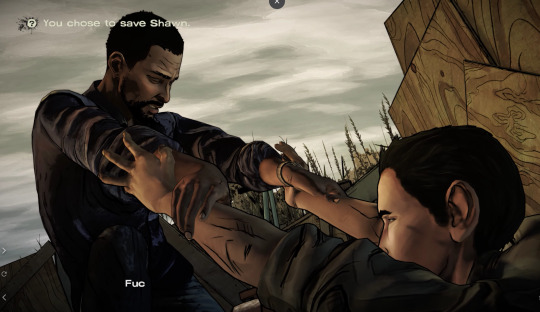
1. Story and Gameplay Mechanics Work Seamlessly Together
The Walking Dead is set in a world hit by a zombie virus. Each season, you take on the role of the main character and have to make choices that reflect the human struggles in this world. That's the heart of the game.
The Walking Dead is all about making tough choices, and the game lets you experience the story while choosing from different options that you think are right for the character. As you play, you start as an observer, but eventually, you become one of the characters and start affecting the story.
For example, in the first season, you're constantly making moral choices in a time crunch, like whether to save Kenny's son or help another teammate. These choices affect the trust between the characters and the plot's future. This is what makes the game so immersive and emotionally resonant for players.
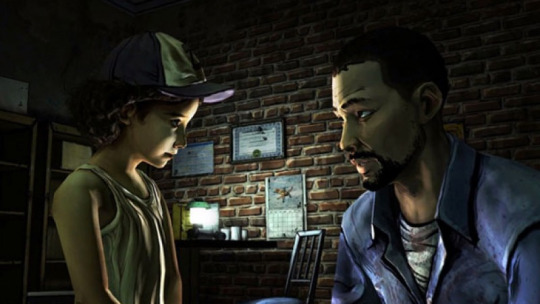
2. Character Design Evokes Strong Emotional Connections
Like I said before, The Walking Dead lets you make many choices. So, instead of saying that the player is playing a character, it's better to say that the player is really acting out of their own will, going through a series of choices, and becoming the character that they’re playing in the game.
This makes the player's emotional connection to the character more profound and stronger. It also creates strong emotional connections with other characters in the game.
For example, in the first season, players must play the main character, Lee, to care for a young girl named Clementine. As the game progresses, most players develop a deep connection with Clementine and want to protect and educate her.
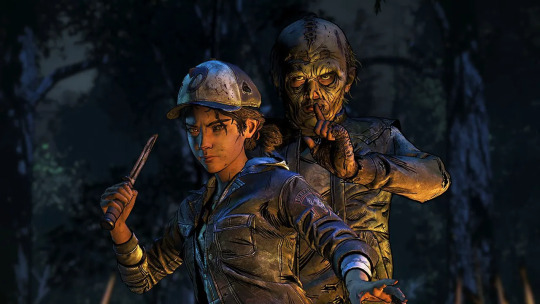
3. Comic-Style Art Design Enhances the Experience
The Walking Dead is based on a comic book by the same name. Instead of using a realistic art style, the game adopts a comic book style closer to the original.
This not only echoes the original manga and satisfies fans of the original manga but also gives the game's art style a unique visual recognition in the wider game community.
After all, The Walking Dead is set in a zombie-ridden world, and the story must be filled with gory fight scenes, so the art style avoids the overly realistic gore and achieves a more tense and artistic performance.

Conclusion
I'm a big fan of The Walking Dead. Besides the three points I mentioned, I also like that at the end of the game, a statistic table always shows which choices are most and least popular. This makes me feel connected to other players and allows me to think about my choices.
Overall, The Walking Dead offers a unique and interactive continuation of the player experience.
Reference
Game Developer (n.d.) The Walking Dead: Let Gameplay Support the Story. Available at: https://www.gamedeveloper.com/design/the-walking-dead-let-gameplay-support-the-story (Accessed: 5 January 2025).
Game Developer (n.d.) Classic Postmortem: Telltale Games' The Walking Dead (2012). Available at: https://www.gamedeveloper.com/design/classic-postmortem-telltale-games-the-walking-dead-2012 (Accessed: 5 January 2025).
2 notes
·
View notes
Text
8. The Role of Game Art in Enhancing Gaming Experiences
With all the competition in the gaming industry, game art has become the first thing gamers notice about a game. When browsing for new games on Steam, art is one of the main things I look for. But it doesn't necessarily have to have beautiful graphics or AAA-level artwork for me to be willing to buy a game. So, I started thinking about how game art affects the gaming experience. What's the role of game art in a game? After reading articles on the subject, I came up with three things.
1. Environment Art: Creating a Believable Visual World
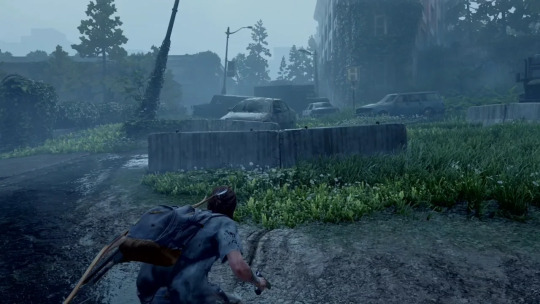
When you put aside the game's mechanics, the most interesting part is the world the game has created. It doesn't matter if the world is fantasy or realistic; the goal is to let the player enter a world the game designer made. And that's where game art shines. After all, we're visual creatures, right? Even if the story is about a beautiful and fascinating world, most people will have difficulty imagining what it's like if they don't see the images.
That's why environmental art is so important in-game art. Good environment art isn't about how realistic or beautiful it is. It's about understanding the game's worldview and creating an environment that makes the players feel like they're there. It also helps players quickly understand the game's worldview visually.
Example:
The Last of Us is a great example of environmental art that feels like part of the game. The crumbling cities, moss-covered buildings, and quiet natural landscapes don't just make the post-apocalyptic world feel real. They also let players feel the oppression and loneliness that's everywhere. These details aren't just for show — they're part of the game's story, making you feel like a post-apocalyptic world.
The main goal of environmental art in games is to blend the virtual and realistic elements of the game, finding the right balance so that players can feel immersed in the visual and spatial aspects of the game.
2. Character Design: Building Emotional Connections
Another thing to remember is that character design is meant to help the player build an emotional connection with the game character.
Most games let you take on the role of a character and adventure through the game world. But how to let players from all over the world play the same character and successfully build an emotional connection with that character is a very important task of character design in game art. It's not just about drawing a character's appearance but also creating a convincing look based on their personality and world.

Example:
In Horizon Zero Dawn, the main character, Eloi, has a costume that mixes primitive tribal style with high-tech elements. This expresses the contradiction between humans and machines in the game world. This design helps the player appreciate her appearance and understand her identity and spirit of adventure, making them more invested in her journey.
3. Symbols and Colors: Conveying Messages and Emotions
The third thing to remember is that the game art should carefully handle the message and emotion conveyed by every symbol and color in the game.
Every symbol and color in the game can influence how the player understands it as they play. Good symbols and colors can help players understand an unfamiliar worldview more easily and immerse themselves in the game more quickly.
Example:
Take The Witcher 3: Wild Hunt, for example. The flags and architectural patterns of different regions show different cultures and histories. The use of cool colors in the game gives the player a sense of the harshness of the northern kingdoms, while the warmth of candlelight and the texture of wood create an atmosphere of safety and comfort, helping the player to adapt to the environment and experience the plot quickly.
Conclusion
Overall, the game's art does a good job of getting the players to feel like they're there in the game world. After reading the articles, good game art is to understand the game's worldview and core mechanics and then create a visual world unique to the game through environments, characters, symbols, and colors.
Reference
Inventive Studio (n.d.) 'How game art style can enhance your project,' Inventive Studio. Available at: https://www.inventivestudio.co.uk/how-game-art-style-can-enhance-your-project/ (Accessed: [6 Jan 2025]).
Ixie Gaming (n.d.) 'The impact of game art on player experience,' Ixie Gaming. Available at: https://www.ixiegaming.com/blog/the-impact-of-game-art-on-player-experience/ (Accessed: [6 Jan 2025]).
Rocky Mountain College of Art + Design (RMCAD) (n.d.) 'Game art and virtual reality: Creating immersive experiences,' RMCAD. Available at: https://www.rmcad.edu/blog/game-art-and-virtual-reality-creating-immersive-experiences/ (Accessed: [6 Jan 2025]).
0 notes
Text
7. The Role of Symbolism in Game Concept Art

In games, concept art gives players a visual worldview, letting them understand a fantasy world with their eyes. It also plays another critical role: guiding players to enter, immerse themselves, and play the game smoothly. Currently, symbolism is a huge deal in conceptual art because different shapes and colors of symbols can help conceptual art convey messages visually, which improves players' immersion and interactive experience. Below are three ideas for using symbols in concept art.
1. Colors and Shapes Influence Emotions and Direction
Colors and shapes have always been the most direct tools of symbolism.
Colors have specific messages:
Warm colors express passion, safety, danger, and more intense emotions, like red, orange, and yellow, often symbolizing enthusiasm, security, and risk.
Cold colors, like blue and green, create indifference, mystery, and bleak emotions.
Shapes can help players understand situations quickly without needing explanation. For example, question marks or exclamation points above NPCs' heads in RPGs immediately signal the quest type.
In games with rich worldviews, using colors and shapes helps players process complex information and quickly connect with unfamiliar settings.
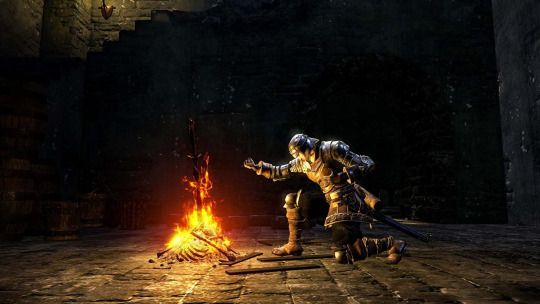
Example:
In Dark Souls, the campfire acts as the game’s safety point. Its warm orange-yellow glow symbolizes hope and security, while the circular design conveys stability and harmony. Conversely, hostile areas use cold, sharp colors and jagged shapes to create a sense of danger, enabling players to identify threats intuitively.
2. Symbols and Totems Convey Culture and Backstory
Well-designed symbols and totems enrich the game’s world, making it more three-dimensional and immersive. Compared to lengthy textual narration, symbols can visually and intuitively convey cultural and historical context.
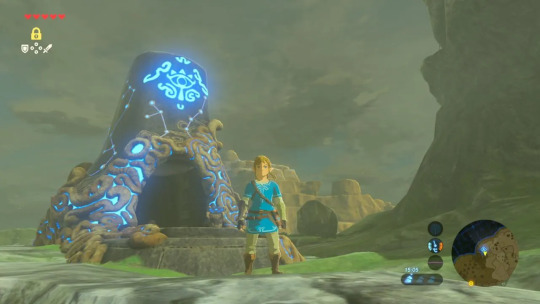
Example:
In The Legend of Zelda: Breath of the Wild, the ancient Shikha symbols adorning temple entrances hint at the temple’s origins and the Shikha people's technological culture. Even if players cannot directly interpret the symbols, their presence adds depth to the environment and invites exploration, creating a vivid and immersive world.
3. Contextualized Symbols Enhance Story and Emotional Resonance
A game’s environment should align with its story to create a cohesive experience. If visuals and narratives are disconnected, players may feel detached. Adding contextual symbols to environments strengthens storytelling and emotional engagement.
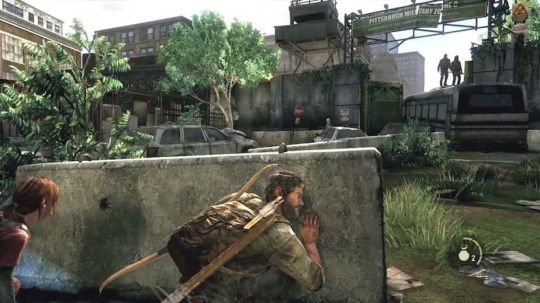
Example:
In The Last of Us, abandoned homes and broken objects vividly depict a post-apocalyptic society. Small details, like teddy bears or children’s graffiti, evoke the lives of unseen characters, intensifying the emotional impact and making the world feel more real.
Conclusion
Symbolism is vital in-game concept art, serving as an invisible language that enhances player immersion and emotional connection. Game designers can convey complex narratives and emotions more powerfully than words by skillfully using colors, shapes, and contextual symbols. Symbolism is the key to unlocking the world of game concept art, guiding players through a meaningful and engaging journey.
Reference
Dyess, C. (2020) 'Semiotics: The unspoken language of graphic design,' Medium. Available at: https://dyessdesign.medium.com/semiotics-the-unspoken-language-of-graphic-design-592db4f6c226 (Accessed: [6 Jan 2025]).
Lee, C. (2020) 'De-signing the design: The semiotics of choice,' Game Developer. Available at: https://www.gamedeveloper.com/design/de-signing-the-design-the-semiotics-of-choice (Accessed: [6 Jan 2025]).
Reddit user (2021) 'Semiotics: How you're already using it and how you can use it better,' Reddit. Available at: https://www.reddit.com/r/DnDBehindTheScreen/comments/mmgj75/semiotics_how_youre_already_using_it_and_how_you/ (Accessed: [6 Jan 2025]).
1 note
·
View note
Text
6. Celeste Game Mechanics and Narrative
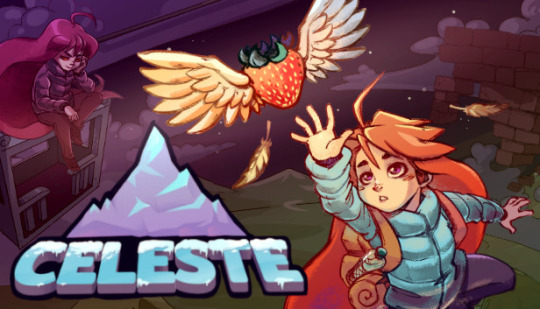
I came across this game because it was very popular. It had great reviews on Steam and a lot of other positive feedback, so I was curious how a game with mechanics and art that seemed unoriginal could stand out among all the indie games out there. So, I started playing Celeste to see what all the fuss was about.
After a while, I got Celeste and realized how great it was. The game is about Madeline, the main character, who decides to climb a mountain called Celeste to figure out her current state of being because of some bad things in her life. It's a relatable story for gamers because it shows that everyone deals with mental health issues like self-doubt and depression as they grow up. The cool thing about Celeste is that it doesn't just tell a story; it uses gameplay and storytelling to let you experience it in an immersive way. Celeste's gameplay mechanics are exceptionally well-designed.
Here are three reasons why I think Celeste's gameplay mechanics and storytelling work so well together:
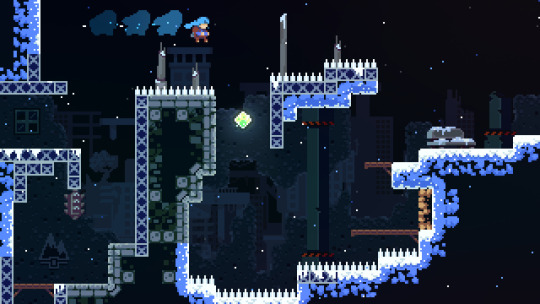
1. Gameplay Reflects the Main Character's Inner Struggles
The gameplay and Madeline’s internal battles are seamlessly integrated.
Celeste is a platform-jumping game similar to Mario, where the player must climb a high mountain using three core skills: jumping, sprinting, and climbing. You're bound to die countless times during the game, but these failures symbolize Madeline's struggles and resilience in facing her inner anxiety.
The game's user-friendly save point system further supports this. You can save at any point in the game, enabling the "death resurrection" method where you repeatedly retry failed sections. This design and the protagonist’s story make it clear that Celeste conveys an important message: frustration and failure are integral to growth.

2. Level Design Mirrors the Protagonist's Psychological State
One of the most exciting aspects of Celeste is how every level is designed to reflect Madeline's mental state. This immersive approach deepened my connection to the character and her mindset.
For example, in the Mirror Temple, the labyrinth-like design and mirrors symbolize the confusion and anxiety Madeline feels when facing her fears. This level also introduces Madeline, Madeline’s negative counterpart. Madeline is not only a boss the player must overcome but also represents the protagonist's inner turmoil. The game uses this duality to explore why Madeline's mind is split into two selves and how she can reconcile with her darker side.
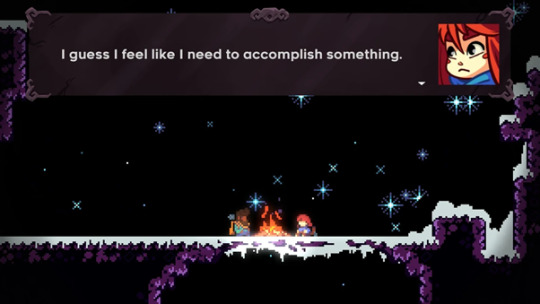
3. Simple Yet Thought-Provoking Story and Dialogue
Celeste features only five characters, but their conversations are simple and impactful, with each line encouraging deep reflection.
For instance, dialogues between Madeline and Badeline prompt players to think about self-acceptance, the importance of inner dialogue, and how to approach oneself with compassion rather than criticism. Similarly, the conversations between Madeline and Theo, a fellow climber, offer insight into dealing with overwhelming anxiety and emotional exhaustion.
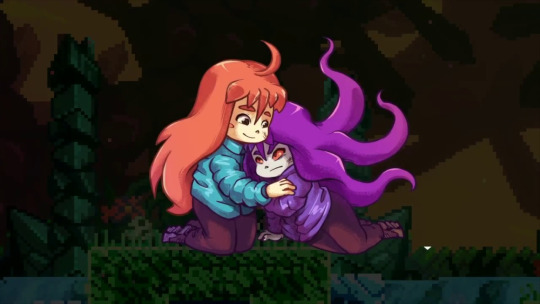
Conclusion
Celeste is not just a challenging platformer; it’s a game that resonates deeply with players by addressing mental health and teaching strategies for coping with anxiety. Blending gameplay and storytelling creates a physically challenging and emotionally profound journey.
The mountain in Celeste represents something different for each player, but the game’s central message remains clear: as long as we keep trying and accept ourselves, we can find our path.
Celeste is a testament to how games can combine mechanics and narrative to deliver robust, meaningful experiences.
Reference
Derek ex Machina (2019) 'Celeste and the symbiotic relationship with difficulty and narrative,' Derek ex Machina Blog. Available at: https://www.derekexmachina.com/blog/2019/5/05/celeste-and-the-symbiotic-relationship-with-difficulty-and-narrative (Accessed: [6 Jan 2025]).
Epilogue Gaming (n.d.) 'Playing the narrative: Celeste,' Epilogue Gaming. Available at: https://epiloguegaming.com/playing-the-narrative-celeste/ (Accessed: [6 Jan 2025]).
Point N' Think (n.d.) 'Celeste philosophy,' Point N' Think. Available at: https://www.pointnthink.fr/en/celeste-philosophy/ (Accessed: [6 Jan 2025]).
0 notes
Text
5. The Impact of Netflix on Japanese Anime
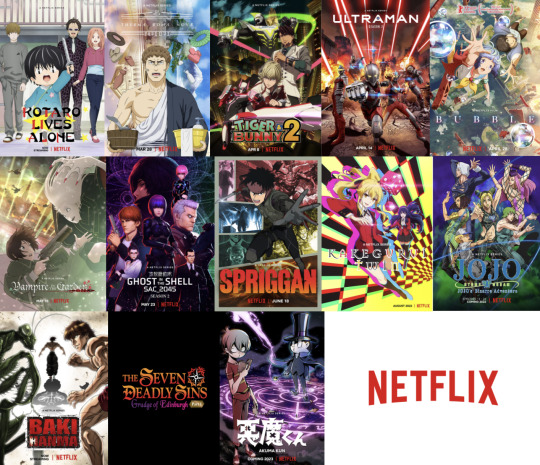
Since I was a kid, I've always been a fan of manga and animation. As I've grown up, I've noticed that the structure of the entertainment industry has changed, and my favorite anime and manga have also evolved.
The most obvious change is the increase in the number of animated comics. When I was younger, most manga needed a certain level of fame to qualify for animation. However, with the launch of streaming platforms like Netflix, more manga have been adapted into anime. I’d like to explore the impact of Netflix on Japanese anime.
Positive Impacts of Netflix on Japanese Anime
According to the article Global Media Streams: Netflix and the Changing Ecosystem of Anime Production, Netflix’s entry into Japanese anime has brought two significant benefits:
1. Increased Funding and Creative Freedom
In the past, anime production relied on multiple production committees, where risks and funds were shared among various members. While this approach reduced financial burdens, it often slowed production and limited creative freedom due to the need for consensus among committee members.
With Netflix’s involvement:
More funding is available for anime projects.
Creative constraints are relaxed since, as an online platform, Netflix doesn’t adhere to traditional media regulations or require approval from multiple stakeholders.
This has enabled more ambitious storytelling and innovative content.
2. Access to a Wider Global Audience
In the past, non-Japanese residents had limited options for accessing anime:
Purchasing rights for local TV broadcasts.
Searching for pirated versions online.
Netflix has changed this by allowing people worldwide to access the latest anime directly on its platform. Viewers can now legally support their favorite works without waiting for international licensing deals or resorting to piracy.
These factors have significantly boosted the global visibility of Japanese anime, creating opportunities for lesser-known works to gain recognition and enabling more manga to receive animation adaptations.
Negative Impacts of Netflix on Japanese Anime
However, Netflix’s involvement is not without drawbacks. Two key challenges stand out:
1. Poor Animator Welfare Remains Unresolved
While Netflix provides generous funding for anime production, the working conditions for animators remain troubling.
Animators are still paid per frame at low rates, leaving frontline workers with insufficient income despite the industry’s growth.
This systemic issue, rooted in the labor structure of the animation industry, discourages young talent from pursuing careers in animation.
2. Conflicts with Traditional Media Distribution
Traditional anime production involves collaboration among publishers, music companies, and merchandise producers to promote anime and its peripheral products.
Netflix’s exclusive distribution rights disrupt this system, limiting how fans interact with the anime through merchandise or other media.
This change may deter other companies from investing in anime, reducing the diversity of experiences available to fans.
Conclusion
Netflix has brought more benefits than harm to Japanese anime. Streaming platforms have helped anime transition from being a subculture to entering the mainstream, making it more accessible to global audiences.
However, the asymmetrical interdependence between Netflix and the anime industry is a potential risk. The sector must avoid overly relying on a single platform and ensure its creative and financial independence.
Regardless of whether Netflix’s involvement is ultimately good or bad, one thing is clear: the future of anime will be shaped by its
interactive collaboration with online platforms
Reference
Clark, T. (n.d.) 'Japan’s anime industry is growing, and Netflix wants a piece of it,' Substack. Available at: https://travisclark.substack.com/p/japan-anime-growth-netflix-streaming (Accessed: [6 Jan 2025]).
Noh, S. (2023) 'Global media streams: Netflix and the changing ecosystem of anime production,' Television & New Media, 25(3), pp. 234–250. Available at: https://doi.org/10.1177/15274764231206540.(Accessed: [6 Jan 2025]).
0 notes
Text
4. The Impact of AI Art on Concept Art
“Everyone is looking for the hack - the secret to success without hard work.”
— OpenAI CEO, Sam Altman

Nowadays, more and more diversified AI is being developed. With the emergence of various AI tools, we are increasingly accustomed to using AI to get the answers we want. There’s also a growing trend that integrating AI into our workflows is becoming essential—otherwise, we risk being left behind. However, the emergence of AI also allows us to rethink the significance of creativity for us as human beings. I don't think AI can replace human creativity. There are two reasons for this:
1. AI's Creations Depend on Reorganizing Huge Databases
Most people know that AI operates by sourcing data from vast databases on the internet to generate specific solutions or summarize information. But the critical question is: Where does this huge database come from?
This vast repository is built from human contributions—thoughts, opinions, and original works uploaded by individuals worldwide. People create these databases through their independent thinking, effort, and judgment ability. AI, however, does not scrutinize the quality of this database. As the saying goes, “garbage in, garbage out.” If the database is filled with flawed or biased content, the AI outputs will likely reflect the same flaws.
In contrast, human creation is profoundly different because of our unique life experiences. After analyzing and absorbing vast amounts of data or visual references, we infuse our creations with personal insights, emotions, and narratives, which allow our work to resonate with others. AI lacks this essence—it merely assembles the closest approximation of an answer based on instructions. Without lived experience, I don't believe AI outputs can truly be called "works."

“Generative A.I. art is vampirical - feasting on past generations of artwork even as it sucks the lifeblood from living artists. Over time, this will impoverish our visual culture.”
— Molly Crabapple
2. Ethical and Copyright Issues in AI
As mentioned, AI relies on large datasets to generate its outputs, often raising ethical and copyright concerns. One notable controversy involves AI-generated images. For instance, in one case, an AI drawing bot streamed its process live on Twitch. Someone stole the partially completed sketch, fed it into an AI tool, and re-posted the recreated image on another platform.
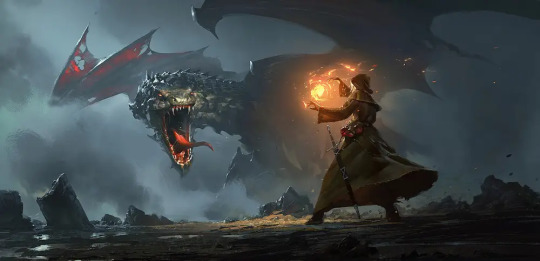

Another example involves AI tools that can simply replicate a specific artist’s style by typing in their name. In both scenarios, artists’ works are used without consent, serving as raw material for AI databases, producing similar outputs. Such practices are harmful and deeply disrespectful to the artists who poured effort and emotion into their creations.
Artists share their work on social media to express their ideas and build their presence, not to have their creations exploited for unauthorized AI use. If this continues unchecked, it may discourage artists from sharing their works altogether, robbing the world of genuine creativity.
Conclusion
Perhaps the use of AI is now inevitable—after all, in a capitalist society, AI significantly reduces costs. However, if we fail to address these issues, our future could be flooded with soulless works of art lacking genuine emotional connection.
AI is just a tool, but our attitudes and approaches are the real issue. If we blindly embrace the convenience AI offers without questioning its implications, we risk losing the uniqueness and depth that define us as human beings.
Let us not forget that while AI can assist, creativity remains an inherently human trait. Our experiences, emotions, and ethics breathe life into art and innovation.
Reference
Corralldesign (n.d.) 'AI harm & hypocrisy,' Corralldesign. Available at: https://www.corralldesign.com/writing/ai-harm-hypocrisy (Accessed: [6 Jan 2025]).
ICANHELP (n.d.) 'The impact of AI art in the art community,' ICANHELP Blog. Available at: https://www.icanhelp.net/blog/the-impact-of-ai-art-in-the-art-community (Accessed: [6 Jan 2025]).
YMT Magazine (2023) 'Why AI art could not thrive without social media,' YMT Magazine. Available at: https://ymtmag.no/2023/Articles/Why-AI-Art-could-not-thrive-without-Social-Media/ (Accessed: [6 Jan 2025]).
0 notes
Text
3. The Growth Curve of Steven Universe's Main Characters
Steven Universe's Growth Curve
Steven Universe is an animated series created by Rebecca Sugar for Cartoon Network. The story summarizes the adventures of Steven Universe and his life with three crystal aliens. In Steven Universe, the character design represents a breakthrough in gender stereotyping, and the LGBTQ imagery in the plot is all worth discussing. However, I would like to discuss Steven Universe's growth as a character I can relate to the most.
The growth of the character of Steven Universe in the show resonated with me. I feel that he has nailed the confusion and anxiety about identity that most young people experience when they are growing up. Steven Universe's growth path can be divided into four stages.
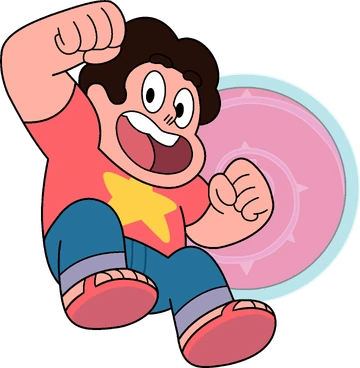
1. Childlike Innocence and Optimism
In the first phase, Steven Universe's childlike innocence, optimism, and desire to be a part of a group led to Steven Universe's early attempts to fit in with Crystal Gems, but the process was filled with setbacks and failures. It was at this point that a key line set the stage for Steven Universe's attitude towards life:
“If every porkchop were perfect, we wouldn't have hot dogs!”
(Season 1, Episode 4, “Together Breakfast”)
This quote demonstrates Steven Universe's understanding that not everything can be perfect, but embracing life's uncertainties is the only way to create more good things.
2. Struggle with Identity
The second phase is when Steven Universe grows up and realizes how important his mother (Rose Quartz) is to the people around him. But it also makes Steven Universe wonder if he's fulfilling his mother's legacy and if he'll ever be able to replace her with a friend who has deep feelings for her. These questions weigh heavily on Steven Universe's mind, leaving his self-identity in turmoil.
“I'm not my mom. I'm my me!”
(Season 4, Episode 8, “Storm in the Room”)
This line expresses Steven Universe's struggle and determination to find self-identity in the face of the huge shadow of his mother.

3. The Daunting Freedom
In the third stage, Steven Universe has solved all her problems and is finally able to enjoy a new life of freedom and liberty. Still, when Steven Universe, who has always put helping others as her core goal, tries to save the planet, the sudden freedom plunges her into a deeper daze.
Like us college graduates, in the age of information explosion, the Internet is filled with millions of lifestyles, and the seemingly more unrestrained age of social media implies what society expects from people of all ages. With such confusion, Steven Universe puts it in the following words:
“Why is everything so easy for everyone else but so hard for me?”
(“Everything's Fine,” Episode 19)
This line expresses Steven Universe's sense of desperation in the face of internal and external pressures, revealing his loneliness and struggle while also illuminating the loneliness of modern people in figuring themselves out.

4. Acceptance and Vulnerability
In the fourth stage, Steven Universe finally realizes that he doesn't have to figure things out on his own and pretend to be strong all the time. He learns to admit his confusion, accept his vulnerability, and ask for help from his friends and family who are worried about him to get out of that abyss of loneliness.
“I can't keep it together anymore... I need help.”
(“I Am My Monster,” Episode 20)
Conclusion
Steven Universe is a boy with superpowers, but anyone confused about growing up can see themselves in this character. His growth path is quite ordinary, and in this era of entertainment explosion, one can find a more dramatic character than Steven Universe. However, the ordinary growth path of Steven Universe will resonate with all the viewers of this animation.
Reference
Bit the Dark Side (2017) 'Steven Universe and emotional logic storytelling', Bit the Dark Side Blog. Available at: https://bithedarkside.wordpress.com/2017/04/09/steven-universe-and-emotional-logic-storytelling/ (Accessed: [6 Jan 2025]).
Huck Magazine (n.d.) 'Cartoon Network’s socially conscious Steven Universe', Huck Magazine. Available at: https://www.huckmag.com/article/cartoon-network-socially-conscious-rebecca-sugar-steven-universe (Accessed: [6 Jan 2025]).
Poet of the Piano (2020) 'Character analysis on Steven in SU Future: Part 1', Tumblr. Available at: https://www.tumblr.com/poetofthepiano/614990530366095360/character-analysis-on-steven-in-su-future-part-1 (Accessed: [6 Jan 2025]).
0 notes
Text
2. Is Adapting Games into Other Forms of Media Good or Bad?
The Adaptation of Games into Other Forms of Production
Adapting games into other forms of production is quite commonplace in today's entertainment industry. For example, the 2023 Super Mario Bros. movie, HBO's adaptation of The Last Survivor, and the recently released second season of Arcane are all video adaptations based on famous games.
But we all know that not all game adaptations are popular with the general public or fans, so I'd like to think about this question: just like for the games themselves, is an adaptation necessary?
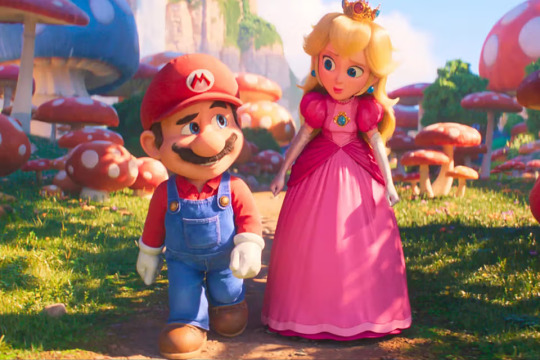
Benefits of Adapting a Game into a Movie or a Book
1. Expanding the Audience and Brand Influence
Famous game series usually have a huge fan base, but unfortunately, these fans are usually limited to the general public with the habit of playing games. Game adaptations are a great opportunity to reach out to non-gamer audiences! For example, after The Witcher series was adapted into a movie, the sales of its games increased dramatically, attracting the attention of more non-players of the original game.
2. Exploring the Game’s Narrative, Characters, and Worldview
Due to the limitations of interactive gameplay, players can understand and absorb the game's worldview or recognize the characters in the game according to their wishes. Therefore, as a game's worldview grows, most players will miss some of the game's side stories or characters that are not part of the main storyline. For this reason, a movie or film can provide a more complete story to the audience and the player, allowing the player to understand the game from a different perspective.
For example, the movie version of The Last of Us emphasizes the emotional relationship between the characters more visually.
These two reasons are essential to adapting games into video books and movies.
Challenges of Game-to-Film Adaptations
1. Transforming Active Interaction into Passive Experience
The fundamental difference between games and movies is that games are active and passive. The core attraction of a game lies in the player's sense of autonomy and participation. Still, such interaction is forced into a passive narrative when adapted into a movie or film.
For example, the movie version of Warriors of Destruction could not reproduce the immersion of the first-person perspective, resulting in a lukewarm response from the audience. Overcoming this is one of the key points for a successful game adaptation.

2. Balancing Faithfulness to the Original and Innovation
The most important thing about game adaptation is that it already has a complete worldview and characters. However, if the movie or film is wholly adapted from the game, first of all, based on the length of a regular movie, it is difficult to tell all the game content in 3 hours, so some adaptations will inevitably have to be made.
But how to choose between the two is a test of the screenwriter's skill. At the same time, even if it is a movie, if it is completely adapted from the game, it will also cause people who have played the game to deduce the plot, which is very boring.
Therefore, it is crucial to stay true to the original and add new original ideas so that new audiences can understand the game's fascinating worldview and original fans can find new fun in the adapted movie or film.
As Emily Giannusa, Vice President of Marketing for HBO, said, "leaving bread crumbs, not French bread," capturing the core of the game and adding an innovative twist that only a movie or television series can do is the key to their successful adaptation of The Last Man.
Conclusion
If these two challenges can be overcome, the movie or film adaptation of the game might be more engaging.
It's good that games are being adapted into books and movies. After all, it's good if good work can be made known to more people in a different form! Unfortunately, there are a lot of cases where fans have been disappointed by game adaptations, which has led to the public being skeptical about game adaptations at this stage.
However, with more and more cases of game adaptations, we will be able to see more good game adaptations in the future.
Reference
Baty, S., M.A. (2020) The art of the game: Issues in adapting video games. Dissertations, Theses, and Student Research: Department of English. Available at: https://digitalcommons.unl.edu/englishdiss/167 (Accessed: [6 Jan 2025]).
Creativepool (2023) 'The transmedia opportunity for games', Creativepool. Available at: https://creativepool.com/magazine/inspiration/the-transmedia-opportunity-for-games.30427 (Accessed: [6 Jan 2025]).
Science and Media Museum (2019) 'Why do video game adaptations fail?', Science and Media Museum Blog. Available at: https://blog.scienceandmediamuseum.org.uk/why-do-video-game-adaptations-fail/ (Accessed: [6 Jan 2025]).
0 notes
Text
1.
Game Narratives: Breaking the Fourth Wall
In game storytelling, players are often placed in the role of a specific character, allowing them to experience a particular worldview and enjoy a variety of scenarios.
In this context, although players may engage in the game through a first-person perspective, the in-game events, levels, and narrative often shape their connection and emotional response to the character and story. (For instance, players typically don't feel too affected by death in games, as most games allow for resurrection or respawning.)
However, breaking the fourth wall in game storytelling effectively addresses this disconnection.
The "fourth wall" refers to the invisible boundary between the player and the game character—represented by the screen. Players interact with the game character through the screen, but the level of immersion can vary depending on the game.
What does breaking the fourth wall mean?
Breaking the fourth wall involves characters in a game or a piece of theater directly interacting with the player or audience, making them active participants rather than mere observers.
Classic games that break the fourth wall include Undertale, The Stanley Parable, Nier: Automata, and Doki Doki Literature Club!.
One of the key features of these games' storytelling is how characters directly engage with the player. The narrative can change based on the player's choices and reactions, often without the opportunity to replay, making players feel as if they are genuinely part of the game rather than just controlling someone else.
For instance, in the well-known game Nier: Automata, during the final ending, a character asks the player if they are willing to sacrifice their save file to help other players defeat the game's final boss. In this moment, the player becomes an integral part of the game's narrative, impacting the gameplay experience for others.




This method of breaking the fourth wall allows players to form a deeper emotional connection with the story and characters in the game, while also reflecting on how their choices influence the game world. Breaking the fourth wall doesn’t just involve direct interaction between the game characters and the player; it can also include the game creators interacting with players through Easter eggs, such as providing hidden items or special rewards.
In conclusion, I believe that breaking the fourth wall is a powerful narrative technique that helps players engage more deeply with the game's storyline, while fostering a stronger sense of empathy and resonance with the characters.
Citations and References:
Andrea, F (2024) 'Breaking the Fourth Wall | Narrative Perspective Explained,' bibisco, 11 February. Available at: https://bibisco.com/blog/breaking-the-fourth-wall-narrative-perspective-explained/ (Accessed: 18 October). Fairy Fantasy (2017) NieR: Automata - TruE Ending E: the [E]nd of YoRHa (Deleting Save Data). 24 Mar. Available at: https://www.youtube.com/watch?v=WCmnOvidOn8 (Accessed: 18 October).
1 note
·
View note